World 🢖 Europe 🢖 United Kingdom 🢖 England 🢖 Wiltshire
Megaliths 🢔 Archaeological wonders 🢔 Categories of wonders
Wonder
Stonehenge

 In short
In short
The word "megalith" brings one immediate association to many people around the world – Stonehenge. This archaeological monument certainly is a part of popculture. It is silent heroe of numerous movies, paintings, comixes and – countless pseudoscientific theories and even religious movements.
 69.0%
69.0%
GPS coordinates
Location, address
Construction time
Culture
UNESCO World Heritage status
Map of the site
If you see this after your page is loaded completely, leafletJS files are missing.
 In detail
In detail
At a first glance this megalith is far less impressive than many other archaeological wonders of the world. Nevertheless, it is a very distinct, unique landmark without comparable matches worldwide. There are many megalithic monuments around the world called "Stonehenges" (such as "Amazon Stonehenge" in Brazil) – but at a closer look it turns out that these monuments have quite different qualities.
Why Stonehenge is unique?
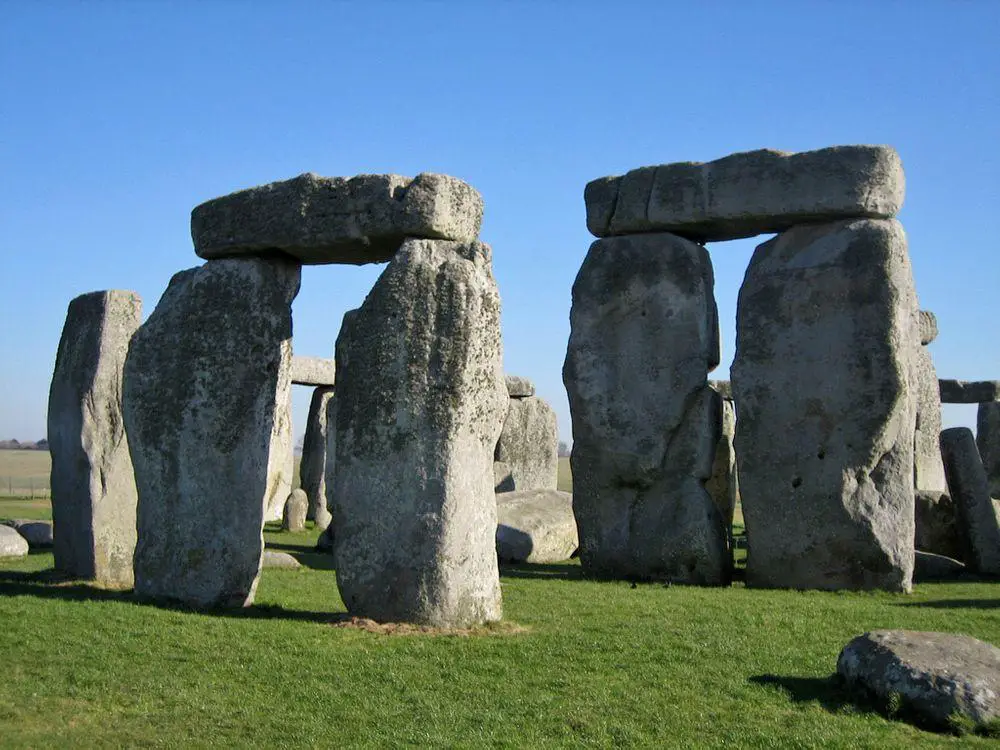
- The history of this monument started approximately 6 500 years (some findings testify that even 10 000) ago, when people established first known cult sites nearby. It seems, cult related activities have continued here for most of the time. Such a long history of worship sites is not common.
- The present stone structure has been erected some 4 500 years ago. Thus it belongs to the oldest existant cult structures in the world – but there are known also older ones.
- Stone settings here have astronomical orientation. Monument has concentric planning with unprecedented sophistication.
- The stones of Stonehenge were hewn with a precision which is uncommon for its time – between 2600 – 2400 BC. The structure itself is unusual – consisting of tall standing stones with lintels on top, forming a large ring. Unusual feature is mortise and tenon joints. Such joints are common for wooden structures but rare for stone structures.
- Stone constructions are large – the tallest trilithon was 7.3 m above the ground level and stones were up to 50 tons heavy.
- Stonehenge is located in the center of the most dense complex of Neolithic and Bronze Age monuments in Europe, including several hundreds of burial mounds. Many of these monuments are very unusual and often the purpose of their construction is unclear. This area served as an important ceremonial complex with Stonehenge as the center of it.
- Here were buried people from other regions of Europe – Mediterranean region, present day Germany, France. Thus this ceremonial center in Neolithic Age was known elsewhere in Europe.
All of these factors combined make Stonehenge unique not only in England but in whole Europe and world.
The history of megalith in periods
Few monuments such a complex history as Stonehenge. The following development stages are identified by many specialists:
- 8000 – 3100 BC: Early period;
- 3100 – 3000 BC: Stonehenge 1;
- roughly at 3000 BC: Stonehenge 2;
- 3000 BC – 2600 BC (2400 BC?): Stonehenge 3 I;
- 2600 – 2400 BC: Stonehenge 3 II;
- roughly at 2300 BC: Stonehenge 3 III;
- 2280 – 1930 BC: Stonehenge 3 IV;
- 1930 – 1600 BC: Stonehenge 3 V;
- 1600 BC – now: later times.
Early period
Most likely we will never know why – but already in 8000 BC the people saw something special in the area around Stonehenge. There have been found traces of postholes located in a row near Stonehenge.
It is almost impossible to find out the early history in such an intensely transformed site as Stonehenge. The earliest known activities in Stonehenge started approximately 6 000 years ago – around 4000 BC here was developed a causewayed enclosure – a circular ditch with an internal bank (henge), crossed by causeways. By this time the site of Stonehenge certainly was of special spiritual significance.
It is known also that some 500 years later – sometimes around 3500 BC roughly 700 m to the north was developed large cursus monument – a structure similar to a wide road with banks and ditches on both sides. It is also known that by this time here was established agricultural society and farmers started to clear the primeval forest here.
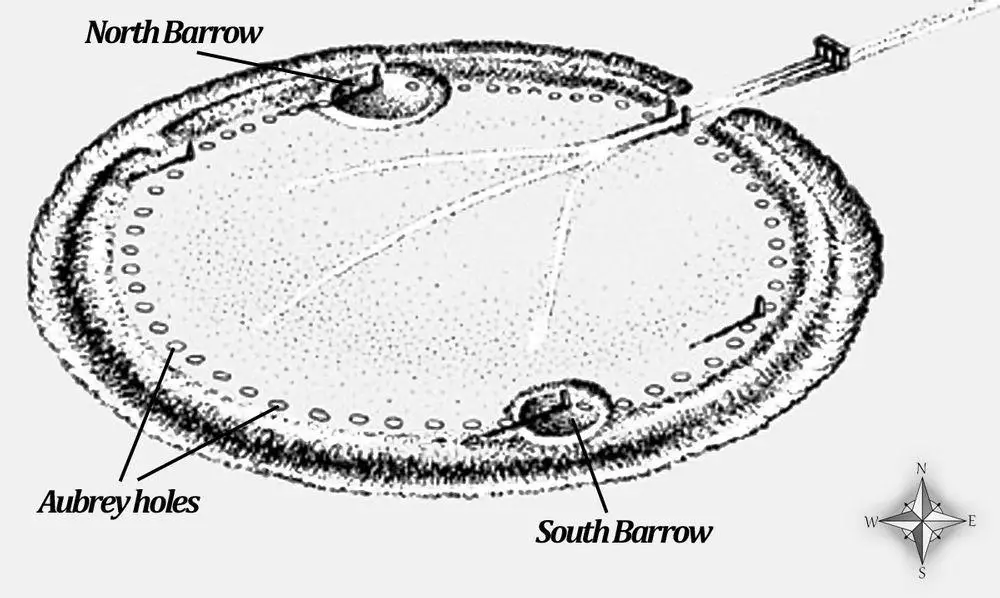
Stonehenge 1
Around 3100 BC in the site of Stonehenge was developed circular bank and ditch enclosure with ditch outside and smaller bank outside the ditch. Diameter – 110 m, larger entrance to the north-east, smaller – to the south. On the bottom of the ditch were placed bones of deer and oxen. Since 3100 BC this ditch has gradually silted up.
Soil here consists of Late Cretaceous chalk.
In the outer rim of the enclosure are found 56 pits – each about a meter in diameter. These holes are called Aubrey holes after antiquarian John Aubrey who possibly first identified them in the 17th century.
It is possible that these pits contained upright timber logs or possibly – stones – thus initially Stonehenge had a large circle.
Stonehenge 2
Next known activities took place sometime around 3000 BC. Traces of this period are not visible above the ground anymore.
Inside the enclosure there were developed timber structures. They were located at the northeast entrance, there was also a parallel alignment of posts inwards from the southern entrance. These postholes were approximately 0.4 m in diameter, not very regularly spaced.
Archaeological evidence shows that at this time Stonehenge served as a burial ground. Burials continued into later periods – at least up to 2500 BC. At least 25 Aubrey holes were used as sites for cremation burials. There are found also other burials, mostly on the eastern side of the enclosure.
This is the earliest known cremation cemetery in the British Isles.
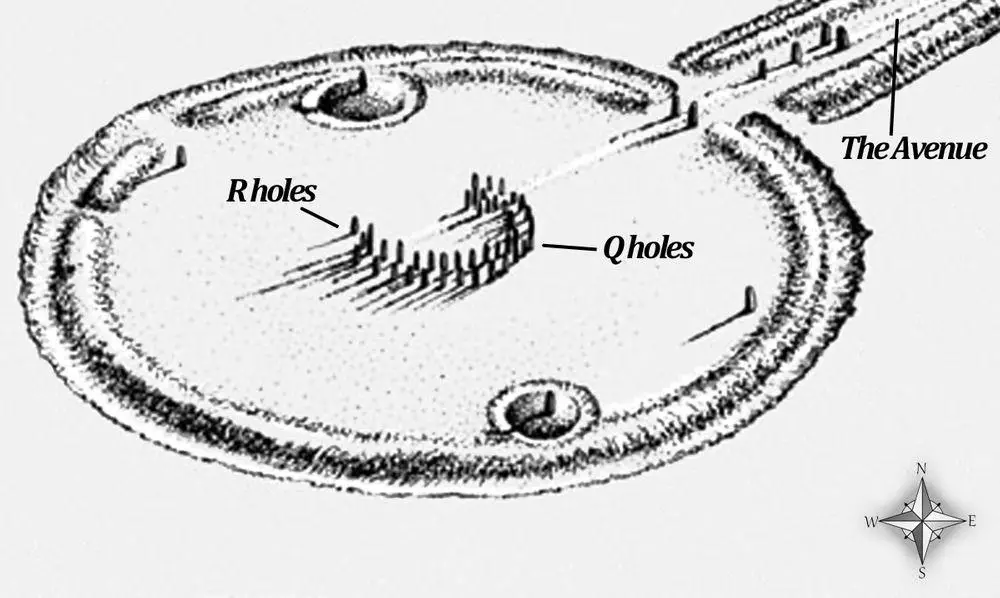
Stonehenge 3 I
Sometimes around 2600 BC (according to late research data – 2400 BC) the developers of Stonehenge shifted to stone.
There were dug two concentric arrays of holes – Q and R Holes – in the centre of the site. It is possible that they formed double ring although the remnants now look like two crescents. It is possible that these holes held up to 80 standing stones. This number is not proved – 43 stoneholes can be traced now.
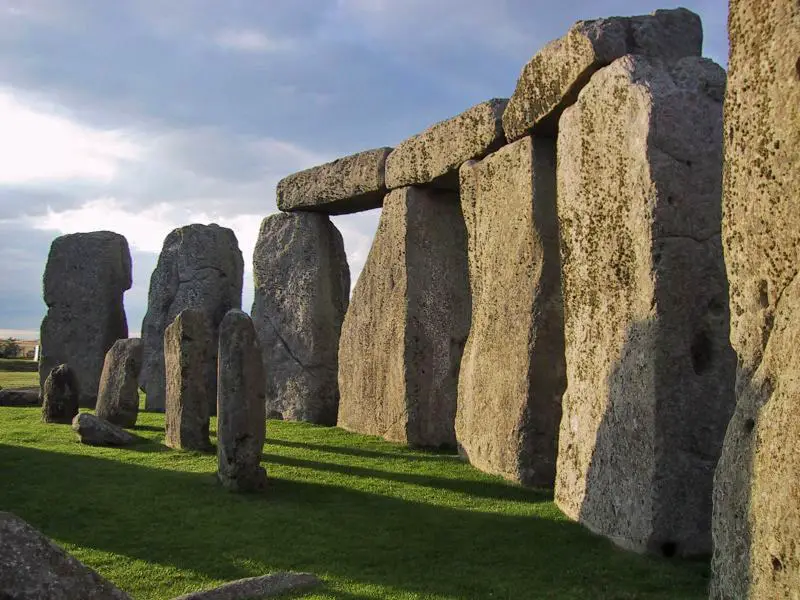
Bluestones
Slightly later there was placed stone ring – Bluestone Circle – which partly is located over these Q and R Holes. Some stones of Bluestone Circle still are in their place.
These are specific dolerites – the famous bluestones of Stonehenge. One exotic theory tells that these 2 – 4 tons heavy stones were specially transported from Preseli Hills in Wales (some 230 km to the west from Stonehenge). Petrological analysis shows that rocks in Preseli Hills are very similar indeed to at least some rocks in Stonehenge. Another theory though tells that these stones were brought from Wales by glacier and then collected in the surroundings of Stonehenge.
In total here were used some 20 different rock types including rhyolite, tuff.
Each of standing stones was roughly 2 m high, 1 – 1.5 m wide and some 0.8 m thick.
It seems that the intended monument was not completed in this period. Small standing stones were removed and the holes filled.
Astronomical orientation
The north-eastern entrance was widened – now it exactly matched the direction of the midsummer sunrise and midwinter sunset of its time.
In the centre was erected so called Altar Stone – larger sandstone slab. It weighs some 6 tons and originally could be almost 2 m tall, it is recumbent. Also this rock is originally coming from Wales.
Most likely in this period there was erected Heelstone – sandstone slab outside the north-eastern entrance. This large stone is approximately 35 tons heavy and is slanting. When looking from the centre of Stonehenge, Sun in summer solstice rises above this stone.
Next to Heelstone was located second stone as well, it is not visible now.
Inside the north-eastern entrance there were placed two or three large portal stones. Now only the fallen, 4.9 m long Slaughter Stone remains.
From this time might originate also the four Station Stones, with two stones atop artificial mounds.
In this time was added also Stonehenge Avenue – parralel pair of ditches and banks leading 3 kilometres to the River Avon.
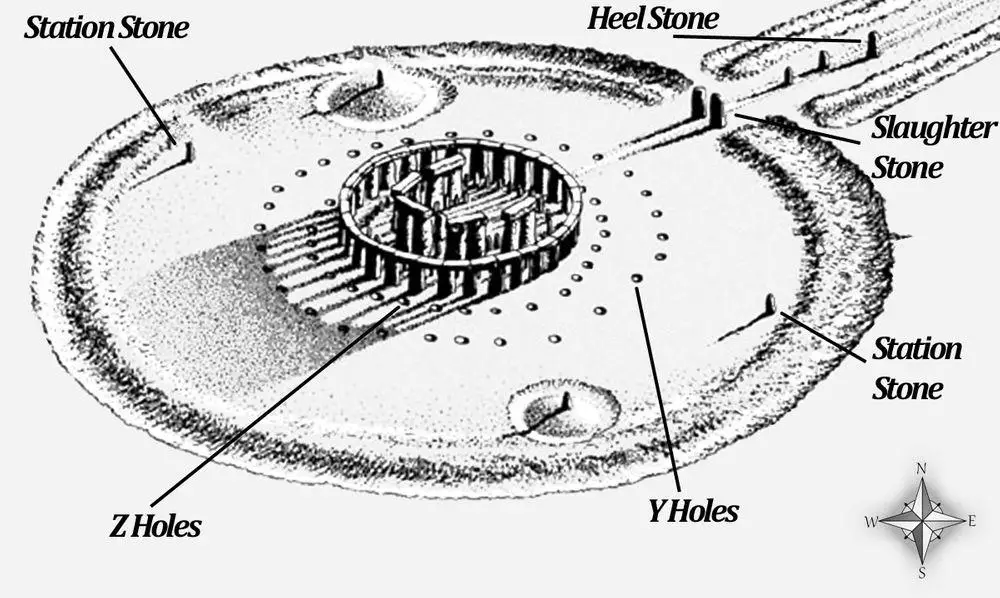
Stonehenge 3 II
In next phase (between 2600 and 2400 BC – 2300 BC) in the site were erected some 30 stones, forming a circle with a diameter of 33 metres. There were placed 30 lintel stones on them, fastened with mortise and tenon joints. Lintels themselves were joined with tongue and groove joint. Both these connection methods are borrowed from woodworking. Stones were worked with high precision. Lintels were slightly curving thus forming a perfect ring. Standing stones were slightly widening towards the top to create wholesome visual impression.
Each standing stone was 4.1 m high, 2.1 m wide, 1.1 m thick, each weighed around 25 tons. The distance between the stones was approximately 1 m.
Each of lintels was approximately 3.2 m long, 1 m wide, 0.8 thick. Tops of lintels are 4.9 m above the ground.
Inward-facing surfaces of this stone ring are more smooth than other surfaces.
To make a circle there were needed 60 stones – thus it is possible that the works were not completed or some stones were removed later.
Trilithons
In the middle of this circle was built another stone structure – five trilithons. Trilithon is a structure consisting of two upright stones with third stone placed horizontally across the top.
Trilithons form a horseshoe shape, with the opening towards north-east. Diameter of this horseshoe is 13.7 m, each stone of trilithons weighs some 50 tons. The largest trilithon is located in the south-west – originally it was 7.3 m tall. One upright stone of this Great Trilithon still is standing – it rises 6.7 m above the ground.
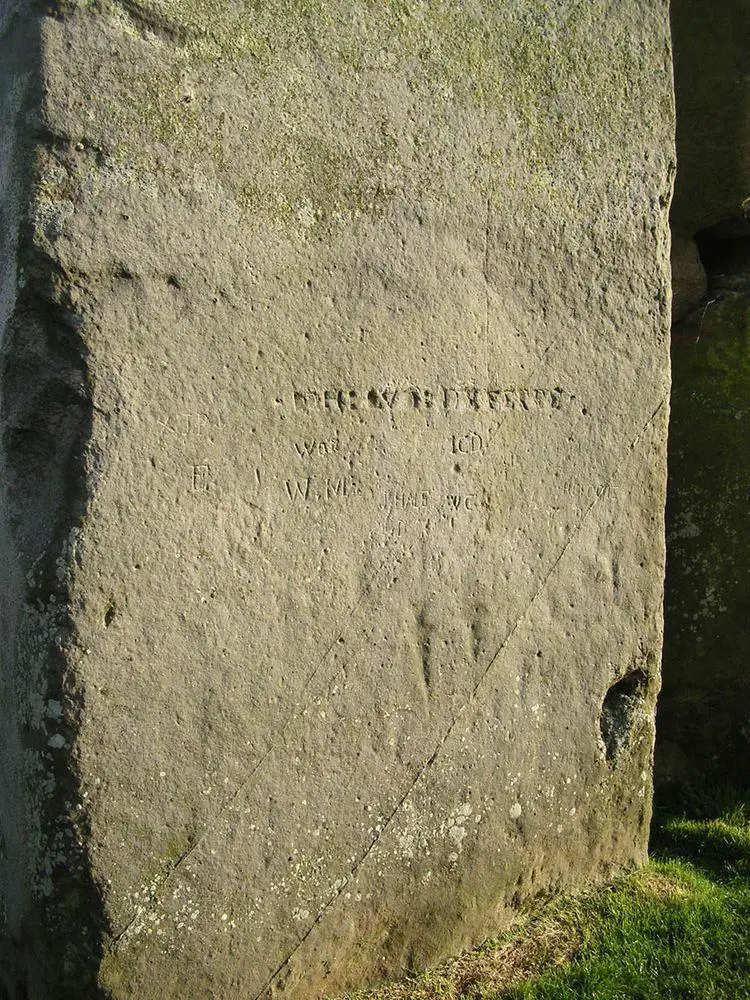
Stone carvings
Interesting features are stone carvings in some of the stones. It is considered that these stone carvings were made in the Bronze Age, around 2300 BC.
Richest collection of these carvings is on one of the stones of trilithons (Stone 53). Here still can be seen something that is similar to a dagger and 14 "axeheads". There are other axehead carvings on stones 3, 4, and 5 in the outer circle.
In these times in the outer ditch of Stonehenge was made a burial – here was buried a man (Stonehenge Archer) with flint arrowheads and stone wrist-guard.
Link to Durrington Walls
Sometimes around 2300 BC there was developed another monument some 3.2 km away in Durrington Walls. Here was built a timber circle which was aligned towards the sunrise in winter solstice – opposite to Stonehenge arrangement. At Avon River, there were huge fires on both banks. It seems that these two monuments – Stonehenge and timber circle in Durrington Walls were linked.
Mike Parker Pearson (Stonehenge Riverside Project) hypothesized that timber circle in Durrington Walls may be represented the "land of the living" but Stonehenge with its stone constructions – "land of the dead". Avon divided both lands.
Later history
There are identified several more periods for the development of Stonehenge.
Stonehenge III is a period of further stone construction in Bronze Age. In Stonehenge 3 IV phase, around 2230 – 1930 BC, many stones were rearranged and the megalithic site obtained its present form. This was done in a less skillful way and as a result, many stones have fallen over time. In Stonehenge 3 V phase, around 1930 – 1600 BC, there was removed the north-eastern section of the outer stone ring – thus both inner ring of trilithons and outer circle were opened towards the sunrise of the summer solstice.
Stonehenge was used for pre-Christian religious ceremonies until Iron Age – afterward, there seem to be no ceremonial activities or they continued on a low scale. The monument itself though has been well known since then in all times.
Preservation and modern worship
The name “Stonehenge” is a comparatively modern invention and most likely originates from “hanging stone” thus describing the stone lintels placed on standing stones.
In written sources this amazing megalith has been mentioned already in the 11th century. This impressive, enigmatic monument became a silent "heroe" of many drawings and other artworks of the Age of Enlightenment and later times.
The land around Stonehenge was donated to the state in 1918. Since the 1920s there started a deliberate policy to turn the area around this prehistoric site first into agricultural land and more recently – into open grassland.
Since the early 20th century the site is used for Neopagan rituals. Gradually this evolved into mass events – free festivals suddenly stopped by violent police interference in 1985. Since 1999 there again are allowed Neopagan rituals.
For longer time stones were available to the public what led to severe soil erosion. Since 1977 the access for the general public is closed. People can access the stones (but not touch them) in solstices and equinoxes.
Purpose of Stonehenge
This well-known archaeological monument has been intensely researched for centuries. Many people have invested much effort to understand the history of this monument, its build technics, purpose. Thus Stonehenge plays a significant role in the development of archaeological research methods.
Stonehenge is built by people who have not left written records. Thus there is plenty of room for theories about the purpose and construction technologies of this impressive stone structure.
Very often these theories pay much tribute to purported mysteries of this megalith and disregard true unsolved riddles (which are less interesting for sensationalists). Thus – much fuss still is made about the handling of the 50 tons heavy stones – although there were developed suitable technologies in the Neolithic period for such works.
The purpose of Stonehenge though is somewhat obscure. It is almost certain that this complex structure was an important element in some important rituals. But we do not know what rituals exactly were performed here. There are indirect proofs that show that there could be practiced rituals linked to healing, burial, ancestor worship. Most likely the site had several kinds of rituals – they changed throughout the year and over the centuries.
References
- Stonehenge Riverside Project. Accessed on March 20, 2011
- Stonehenge, English Heritage. Accessed on March 20, 2011
 Linked articles
Linked articles
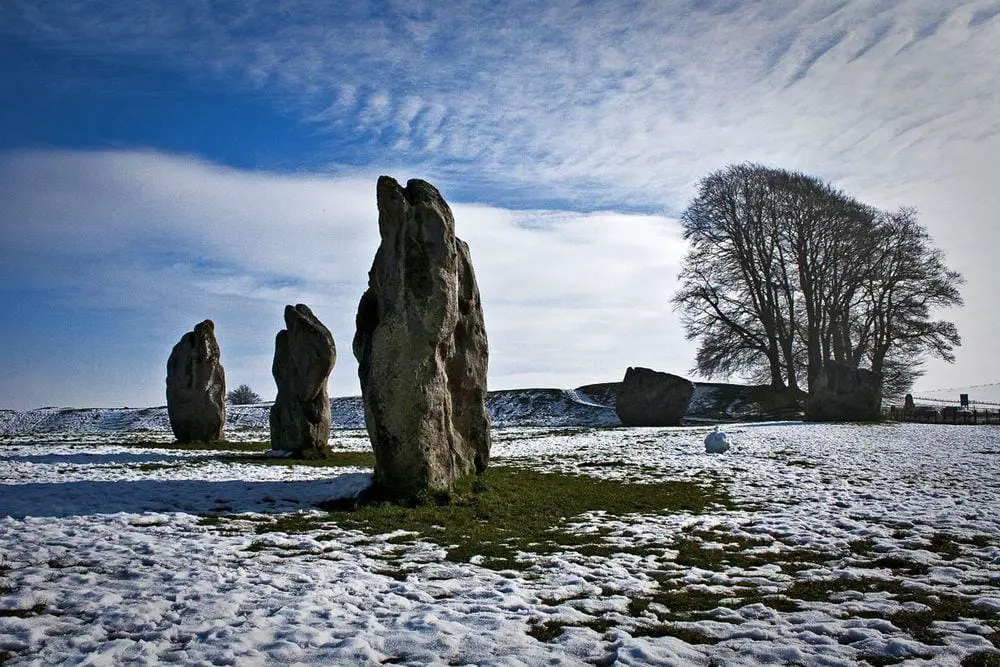
Wonders of Wiltshire
Wiltshire is known worldwide due to its archaeological monuments, especially Stonehenge. This fame is deserved but there is much more than this.
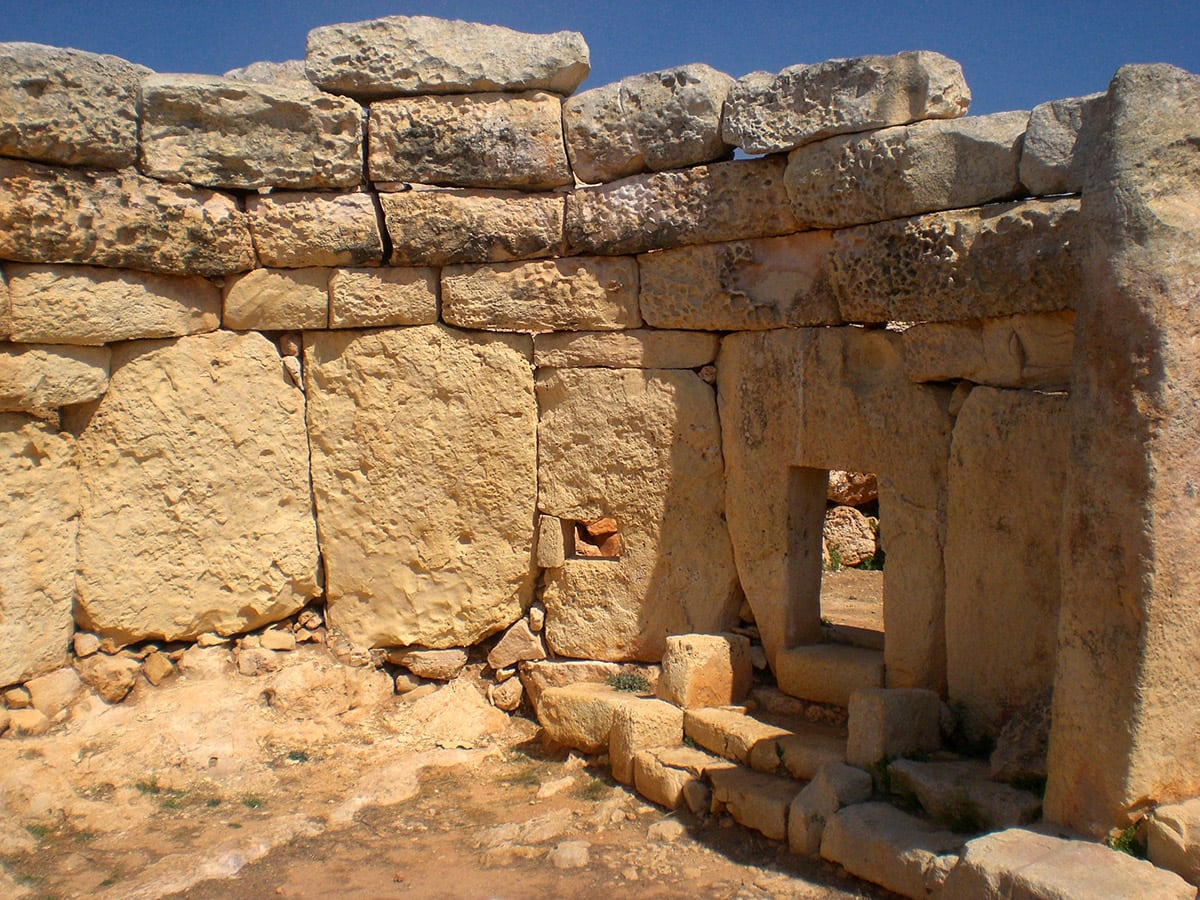
Megaliths
One of the most fascinating groups of archaeological monuments are prehistoric structures made of stones – megaliths. Through the ages, people have loved to strain their minds to find a sensible explanation for the many riddles posed by megaliths.
Even today, we can admit with some pleasure, there are thousands of mysteries left for us.

Wonders of England
The natural and cultural wonders of England are very diverse and here are found some of the world’s most impressive landmarks in several categories, such as churches and museums.
 Recommended books
Recommended books
Stonehenge: Making Sense of a Prehistoric Mystery
Stonehenge is an iconic monument for people all around the world. Built around 5000 years ago, it stands for mystery and forgotten secrets waiting to be decoded. In this latest book in the Council for British Archaeology’s ‘Archaeology for All’ series, Professor Mike Parker Pearson presents an up-to-date interpretation of Stonehenge and its landscape. Drawing on his years of research and excavation, the author presents a highly readable account that is lavishly illustrated with images by the renowned photographer Adam Stanford and the reconstruction artist Peter Dunn.
Prehistoric Wiltshire: An Illustrated Guide
Wiltshire contains some of the most important archaeological sites in Britain. Its Prehistoric remains include the breathtaking Stonehenge, awesome stone circle at Avebury, the enigma of Silbury Hill, and a large number of hillforts. Among these important sites are also found smaller, perhaps lesser-known monuments of the Stone, Bronze, and Iron Ages, including the King Barrow cemetery and Woodhenge.


